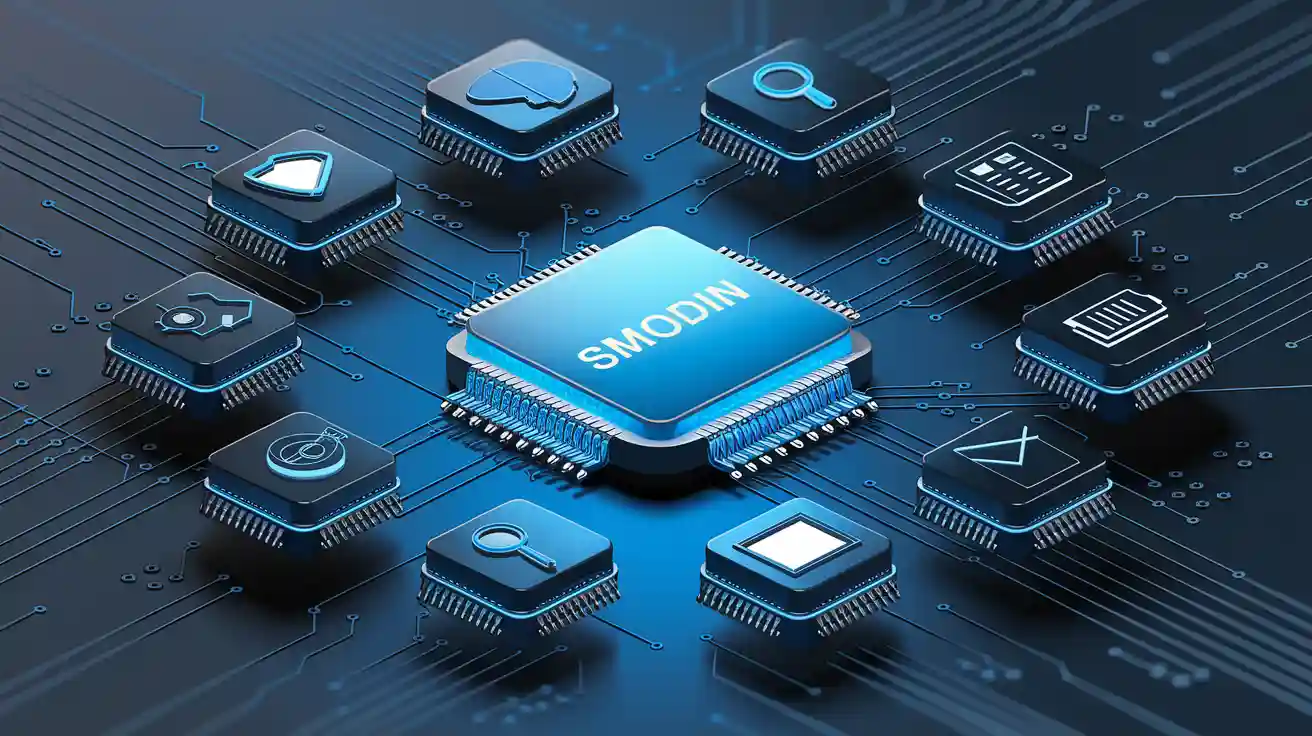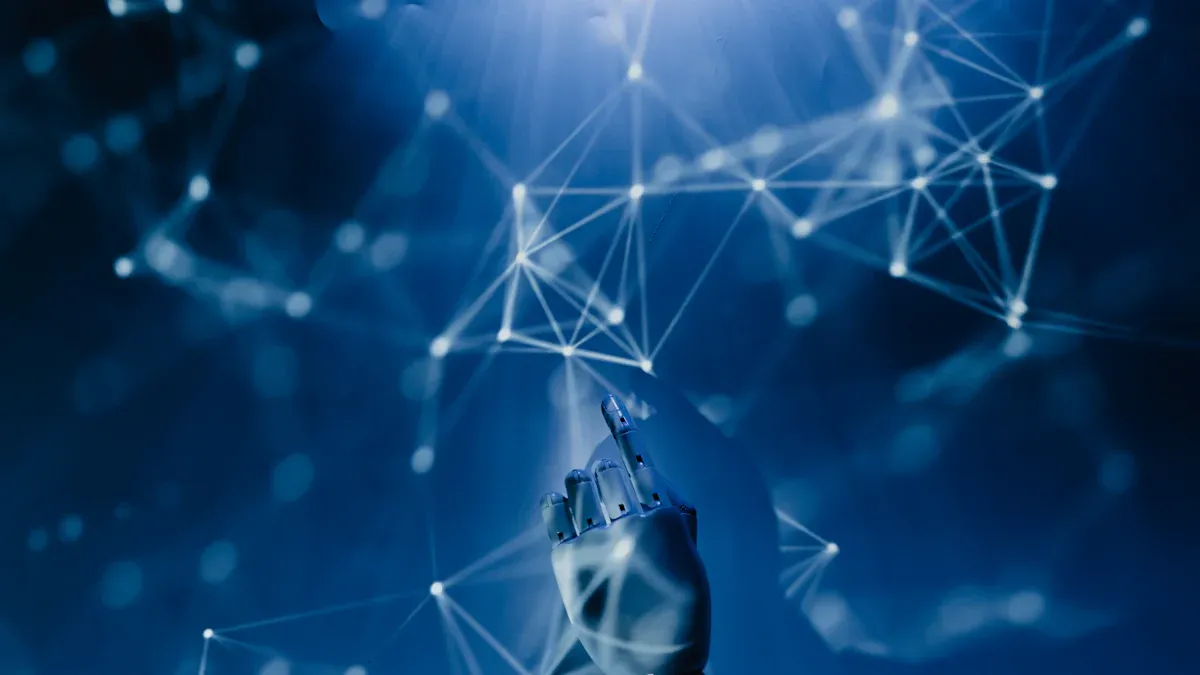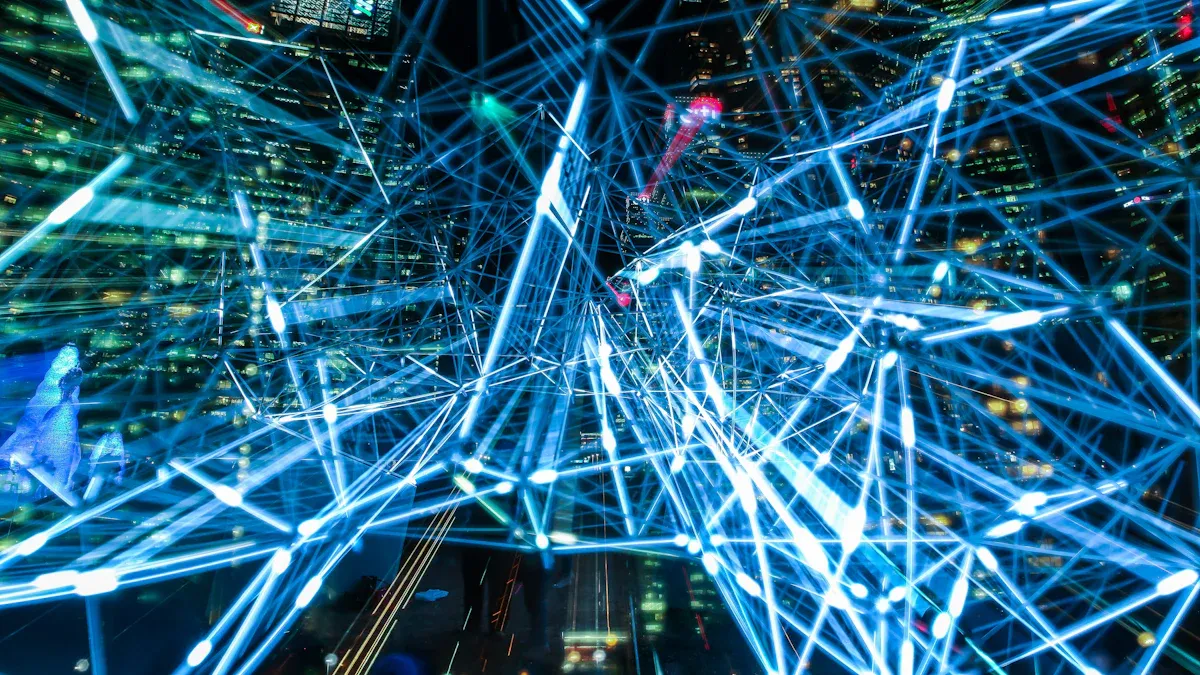
Explore the top 10 ai detectors to try in 2025: smodin ai detector, Copyleaks, GPTZero, TraceGPT, Winston AI, Originality.AI, Turnitin, Writer AI Detector, Sapling, and Crossplag. The need for ai detectors keeps rising as more organizations use ai to create content. In 2025, over 50% of marketing teams optimize content with ai, and nearly 40% of adults have tried generative ai.
|
Statistic Description |
Percentage / Value |
|---|---|
|
Marketing teams using ai to optimize content |
Over 50% |
|
Adults who have experimented with generative ai |
Nearly 40% |
The smodin ai detector stands out for its dual ability to detect ai-generated content and humanize text, making it a versatile choice for both academic and business needs.
Key Takeaways
-
AI detectors help identify if content is created by humans or AI, which is important as AI use grows in many fields.
-
Different AI detectors offer unique features like accuracy, ease of use, and extra tools such as plagiarism checks and text humanization.
-
No AI detector is perfect; combining automated tools with human judgment improves detection accuracy.
-
Choosing the right AI detector depends on your needs, such as education, business, or content creation, and factors like pricing and integration.
-
Regular updates and training of AI detectors keep them effective against new AI content and help maintain trust and transparency.
AI Detectors Overview

What Are AI Detectors
You live in a world where ai shapes how you read, write, and share information. Ai detectors help you identify if content comes from a human or an ai system. These tools scan text, images, audio, and even video to spot patterns that reveal ai involvement. Ai detectors use machine learning, computer vision, and forensic analysis to check for clues. They look for things like sentence structure, word choice, and even hidden digital fingerprints.
|
Aspect |
الوصف |
|---|---|
|
Identify ai-generated or manipulated digital content across text, images, videos, and audio. |
|
|
Detection Methods |
Temporal inconsistencies, facial landmark analysis, compression artifacts, biometric analysis, metadata forensics. |
|
Technologies Used |
Advanced machine learning algorithms, computer vision, forensic analysis techniques. |
|
Machine Learning Models |
Ensemble models trained on diverse datasets to improve robustness and accuracy. |
|
Content Types Detected |
Deepfake videos, synthetic audio, ai-generated text, manipulated images, synthetic identities. |
|
Challenges |
False positives/negatives, generalization to new ai generation techniques, processing delays. |
|
Continuous Training |
Models are retrained regularly to keep pace with evolving ai generation methods. |
Ai detectors analyze linguistic patterns and stylistic features to flag ai-generated content. They use metrics like perplexity and burstiness to measure how predictable or varied the text is. Ai-generated content often shows low burstiness and high predictability. Some detectors even use watermarking, which hides invisible markers in ai-generated text. Most tools give you a likelihood score, showing the chance that ai created the content. You should remember that these scores are not always perfect, so human review still matters.
Why AI Matters in 2025
Ai now touches almost every part of your daily life. In 2025, you see ai in education, business, entertainment, and communication. This rapid growth brings new challenges. You need ai detectors to help you trust what you read and share. Companies and schools use ai detectors to check for ai-generated content in essays, reports, and creative work. As ai systems become more advanced, it gets harder to detect ai content without help.
-
You face rising concerns about trust, transparency, and ethical use of ai.
-
Regulatory compliance has become more important, with over 72% of companies following ai rules in 2025.
-
Transparency matters more than ever, with many people worried about hidden ai use.
-
Data privacy, legal risks, and technical complexity push organizations to use ai detectors.
-
Companies now train employees, review ai systems, and set up codes of ethics to manage ai risks.
Tip: Combining automated ai detectors with human judgment gives you the best chance to detect ai content accurately.
Ai detectors play a key role as you move from exploring ai to holding it accountable. You need these tools to keep up with new ai models and to make sure you can trust digital content.
Top 10 AI Detectors
When you choose an AI detector in 2025, you want a tool that balances accuracy, ease of use, and extra features. You also care about free usage limits, pricing, and customer feedback. To help you compare, here are the top 10 AI detectors you should consider this year. Each tool was tested with the same 1000-word AI-generated essay to ensure fairness.
Selection Criteria:
Detection accuracy
Free word limit
AI humanizer feature
Extra features (plagiarism, grammar, etc.)
Ease of use
Customer feedback
Cost of upgrade
Smodin AI Detector
You can use the smodin ai detector for both identifying and humanizing ai content. This tool gives you detailed confidence scores instead of just a yes or no answer. It recognizes subtle patterns in language and sentence structure, which helps you spot partial ai input. However, it sometimes flags human writing as ai, so you need to review results carefully. The smodin ai detector detects about 30-33% of ai-generated content, which means its accuracy is lower than some competitors. You get a free limit of 5,000 characters per query, and you can upgrade for more features at $15 per month.
Smodin’s humanization tool lets you rewrite text to sound more natural. While this feature is easy to use and works well for short, simple content, it does not bypass advanced ai detectors as effectively as specialized tools. If you want an all-in-one platform with detection, rewriting, and plagiarism checking, Smodin offers broad accessibility and a user-friendly experience.
Copyleaks
Copyleaks stands out for its high accuracy in detecting ai content. Independent tests show it reaches up to 99% accuracy on human-written and ChatGPT-generated text. However, its performance drops to 50% when checking paraphrased content. Some tests report a 40% false positive rate, so you should double-check flagged results. Copyleaks also provides strong AI content fingerprinting, identifying which model generated the text with 99.88% precision. You can use Copyleaks for free with limits, or upgrade for more features. Many users praise its reliability, making it a top choice for schools and businesses.
GPTZero
If you work in education, GPTZero offers a focused solution for teachers and schools. You get an easy-to-use interface and API support for classroom integration. GPTZero helps you detect ai content in student essays and assignments. While its main strength lies in education, details about its speed and accuracy remain limited. Teachers appreciate its simplicity and targeted features, but you may want to compare it with other tools for broader use cases.
TraceGPT
TraceGPT gives you reliable and fast ai detection. It matches Turnitin’s accuracy, reaching 97-98% in tests. You benefit from cost-effective and transparent pricing, and you can integrate it easily with learning management systems. TraceGPT reduces false positives by grading detection results on multiple levels, which helps you analyze mixed human-ai texts. It also detects complex ai paraphrasing better than Turnitin. If you want a lightweight, instant, and reliable tool, TraceGPT is a strong option.
Winston AI
Winston AI achieves a 99% accuracy rate, even when detecting ai-generated content edited by humans. You can analyze deeper linguistic patterns and contextual relationships, and you get support for multiple languages. Winston AI updates its detection models more often than most competitors, so you stay ahead of new ai writing tools. You also receive comprehensive content quality analysis, including readability, engagement, SEO, plagiarism, and keyword density. Winston AI works well for marketing, publishing, and education. Pricing starts at $12 per month, and you can access advanced features with business plans.
Originality.AI
Originality.AI targets professional writers, marketers, and agencies. You can scan for both plagiarism and ai-generated content in one platform. The tool offers a simple interface, batch scanning, and detailed reports. Many users like its transparency and affordable pricing. Originality.AI works well for content creators who need to ensure originality and avoid ai detection issues.
Turnitin
Turnitin combines traditional plagiarism detection with ai detection. You can analyze student submissions for both copied and ai-generated text using a proprietary algorithm trained on GPT-3 and GPT-3.5. Turnitin’s ai detection is less accurate than its plagiarism checker, but it uses a conservative flagging system to reduce false positives. You should use Turnitin’s ai detection as a complement to human judgment and institutional policies. Many schools trust Turnitin for its experience and integrated approach.
Writer AI Detector
Writer AI Detector gives you a user-friendly experience and focuses on business and enterprise needs. You can check for ai-generated content, grammar, and style issues in one place. The tool offers API access for integration with your workflow. Writer AI Detector is popular among content teams who want to streamline editing and compliance.
Sapling
Sapling provides ai detection along with grammar and communication tools. You can use it to check emails, chat messages, and business documents for ai-generated content. Sapling integrates with popular platforms and offers real-time suggestions. Many users appreciate its speed and ease of use, especially in customer service and sales environments.
Crossplag
Crossplag serves as an academic alternative to Turnitin. You can detect both plagiarism and ai-generated content, process batches of documents, and manage users easily. Crossplag connects with learning management systems and offers detailed reporting. Its detection accuracy reaches 81%, making it suitable for institutional use. Pricing is more affordable than Turnitin, and you get plans tailored for individuals and schools. Crossplag is best for educational institutions seeking a cost-effective, dual-function tool.
Tip:
You should always combine automated ai detectors with your own judgment. No tool is perfect, but using the right one for your needs helps you detect ai content more accurately.
Comparison of AI Detectors

Key Features
When you compare ai detectors, you want to know how they perform in real situations. The table below shows how the top tools stack up for ai detection accuracy and speed. You can see which ones are best for your needs.
|
AI Detector |
Detection Accuracy |
Speed/Usability Highlights |
Unique Features |
|---|---|---|---|
|
Originality.ai |
Accurate, clean UI, premium pricing, English only |
Plagiarism + ai detection, batch scanning |
|
|
Copyleaks |
High (~80% real use) |
User-friendly, real-time analysis, may flag human content |
Model fingerprinting, detailed reports |
|
Winston AI |
High |
Fast processing, OCR for scanned/handwritten text |
Multi-language, content quality analysis |
|
GPTZero |
Moderate to High |
Fast, easy to use, free for basic checks |
Education focus, API for schools |
|
TraceGPT |
High (97-98%) |
Instant results, easy integration |
Multi-level grading, detects paraphrasing |
|
Smodin AI Detector |
Moderate (6/10) |
Simple interface, 5,000 character free limit |
Dual detection + humanization, plagiarism check |
|
Sapling |
Claims High (inconsistent) |
Multilingual, enterprise focus |
Grammar, communication tools |
|
Crossplag |
High (81%) |
Batch processing, affordable |
Academic focus, LMS integration |
|
Writer AI Detector |
High |
User-friendly, API access |
Business/enterprise features |
|
Turnitin |
Moderate |
Trusted in education, conservative flagging |
Plagiarism + ai detection, policy integration |
Note: Smodin ai detector stands out for its humanization feature, letting you rewrite ai-generated content to sound more natural. Copyleaks leads in ai detection accuracy for most users.
Pros and Cons
You should look at both the strengths and weaknesses of each tool before you decide. Many users like ai detectors because they are easy to use and save time. You can set them up quickly, even if you do not have technical skills. Some tools give you natural language insights and work well with platforms like Microsoft or Salesforce. Automated dashboards and predictive analytics help you spot ai-generated content faster. No-code environments and clear model logic make these tools more accessible.
However, you may face some challenges. Some ai detectors feel complex if you are new to them. You might find limited customization or advanced features in certain platforms. The quality of your data can affect results, especially for audio or scanned documents. Advanced ai features sometimes cost more or require special licenses. Some tools do not scale well for large companies or lack marketing-specific options. You may need extra IT support or training for the most advanced systems.
Tip: Try different ai detectors to see which one matches your workflow and gives you the best results for ai detection accuracy.
Reviews of Top AI Detectors
Smodin AI Detector
You get a unique experience with Smodin AI Detector. This tool gives you both ai detection and humanization in one place. You can check if your text is ai-generated and then rewrite it to sound more natural. Smodin helps you avoid the “detector trap” by making your writing less generic and more human. Many users say the ai rewriting tool produces grounded, less robotic rewrites. This is helpful for non-native speakers and anyone who wants to pass ai detection. You can refine your content without losing your own voice. Smodin lets you soften or tighten sentences while keeping control of your work. Students, freelancers, bloggers, and non-native speakers often use Smodin to keep their writing authentic and pass ai checks. You also get an AI Grader for educational use, which helps you improve your essays and assignments.
-
Smodin supports editing and adjustment without replacing your style.
-
إن AI Detector and Detection Remover features help your content sound natural and avoid ai detection.
-
Users like Muhammad Hamza say Smodin makes content creation faster and smoother, like having a professional writer always ready.
-
Azalia Baguisa finds Smodin helpful for quick answers, creativity, and support.
Pros:
-
Dual ai detection and humanization
-
Supports many types of users
-
Easy to use
Cons:
-
Sometimes flags human writing as ai
-
Humanization may not bypass all advanced ai detectors
Copyleaks
You can rely on Copyleaks for high ai detection accuracy. The tool checks for ai-generated content and gives you detailed reports. You get model fingerprinting, which tells you which ai model created the text. Copyleaks works well for schools and businesses. Some users report false positives, so you should review flagged content.
Pros:
-
High ai detection accuracy
-
Detailed analysis
Cons:
-
Occasional false positives
-
Premium features cost more
GPTZero
GPTZero focuses on education. You can use it to check student essays for ai content. The interface is simple, and you get quick results. Teachers like the easy setup. GPTZero works best for schools but may not fit all business needs.
Pros:
-
Education-focused ai detection
-
Simple to use
Cons:
-
Limited features for other uses
-
Less detail in reports
TraceGPT
TraceGPT gives you fast and reliable ai detection. You can use it for instant results and easy integration with learning systems. The tool detects complex ai paraphrasing and grades detection on multiple levels.
Pros:
-
High ai detection accuracy
-
Fast processing
Cons:
-
Fewer extra features
-
May need integration setup
Winston AI
Winston AI offers strong ai detection, even for edited content. You get multi-language support and regular updates. The tool analyzes readability, engagement, and more.
Pros:
-
Accurate ai detection
-
Content quality analysis
Cons:
-
Premium pricing
-
Some features for business plans only
Originality.AI
Originality.AI helps writers and marketers check for both plagiarism and ai content. You can scan batches of documents and get clear reports.
Pros:
-
Dual plagiarism and ai detection
-
Batch scanning
Cons:
-
English only
-
Premium pricing
Turnitin
Turnitin combines plagiarism and ai detection. You can use it in schools to check student work. The tool uses a conservative flagging system to reduce false positives.
Pros:
-
Trusted in education
-
Dual detection
Cons:
-
Lower ai detection accuracy
-
Best for academic use
Writer AI Detector
Writer AI Detector supports business teams. You can check for ai content, grammar, and style. The tool offers API access for workflow integration.
Pros:
-
Business-focused ai detection
-
User-friendly
Cons:
-
Limited for education
-
Some features require upgrades
Sapling
Sapling gives you ai detection with grammar and communication tools. You can use it for emails and business documents. The tool integrates with many platforms.
Pros:
-
Fast ai detection
-
Real-time suggestions
Cons:
-
Inconsistent accuracy
-
Best for business use
Crossplag
Crossplag serves schools and individuals. You can detect both plagiarism and ai content. The tool offers batch processing and affordable plans.
Pros:
-
Academic focus
-
Affordable
Cons:
-
Lower ai detection than some tools
-
Fewer business features
Choosing the Right AI Detector
Key Factors
When you select an ai detector, you need to look at several important factors. Each tool offers different strengths, so you should match these to your needs. The table below shows the main factors to consider:
|
Factor |
الوصف |
Example Tools & Notes |
|---|---|---|
|
Accuracy |
Ability to correctly identify ai-generated text while minimizing false positives and negatives. |
GPTZero may have more false positives, while JustDone AI offers deeper analysis. |
|
Ease of Use & UI |
Intuitive interface for non-technical users. |
ZeroGPT and GPTZero are simple; JustDone AI has more features and a steeper learning curve. |
|
Pricing Models |
Cost considerations including free versions, subscriptions, or per-word pricing. |
GPTZero and ZeroGPT offer free versions; Winston AI is more expensive with enterprise features. |
|
Integration Capabilities |
Ability to connect with CMS or writing tools for streamlined workflows. |
Sapling and JustDone AI integrate well with Google Docs and Microsoft Word. |
|
Supported Content Types |
Suitability for different content forms (long-form, short-form, code). |
Varies by tool; important to match tool to content type needed. |
|
Speed & Batch Processing |
Efficiency in analyzing large volumes of text quickly. |
GPTZero is noted for fast analysis, beneficial for bulk checks. |
Tip: Always check if the ai detector updates regularly. New ai models appear often, so you need a tool that adapts quickly.
Matching Needs
You should choose an ai detector that fits your specific use case. In education, accuracy is critical because false positives can affect student records. Tools like GPTZero and Pangram focus on academic integrity and offer integrations with learning management systems. For business, you may need scalable ai solutions with batch processing and workflow automation. Originality.ai and Writer.com AI Detector provide these features and support brand safety. Content creators often need ai detectors that check for plagiarism, support multiple languages, and handle scanned documents. Copyleaks and ZeroGPT meet these needs with web-ready features and free spot checks.
Ai detectors use methods like perplexity and burstiness to spot ai-generated content. These methods help, but they are not perfect. You should combine multiple ai tools and human review for the best results. Regular updates keep ai detectors effective. Without updates, accuracy drops and new ai tricks can fool the system. Modern ai detectors use ensemble methods and daily retraining to stay ahead of threats. This adaptability protects you from deepfakes and keeps your information safe.
Note: The right ai detector helps you maintain trust, meet regulations, and protect your work from manipulation.
You have many options when choosing an ai detector. Smodin works well if you want both detection and humanization. Copyleaks gives you top accuracy for strict checks. For education, GPTZero and Turnitin help keep student work honest. Before you decide, try proof-of-concept tests and check if the tool fits your needs.
-
Prioritize transparency and security.
-
Upskill your team for new technology.
|
Key Takeaway |
Explanation |
|---|---|
|
Set goals before picking a tool to get the best results. |
|
|
Evaluate Across Dimensions |
Look at pricing, support, and integration before you commit. |
Stay curious and test different tools. The right choice helps you keep your content safe and trustworthy.
التعليمات
What is the main purpose of an AI detector?
You use an AI detector to check if content was created by a human or an AI. These tools help you spot AI-generated text, images, or audio. You can trust your sources more when you use them.
How accurate are AI detectors in 2025?
Most AI detectors reach high accuracy, but results can vary. For example, Copyleaks and Winston AI often score above 95%. You should always review flagged content yourself for best results.
Can AI detectors check for plagiarism too?
Many AI detectors, like Smodin and Originality.AI, also scan for plagiarism. You can use one tool to check both originality and AI involvement. This saves you time and effort.
Do AI detectors work with all languages?
Some AI detectors support multiple languages, but many work best with English. Winston AI and Sapling offer multi-language support. Always check the tool’s language options before you start.
Why do some AI detectors flag human writing as AI?
AI detectors look for patterns common in AI writing. Sometimes, your natural writing style matches these patterns. You may see false positives. Always double-check results and use your own judgment.








